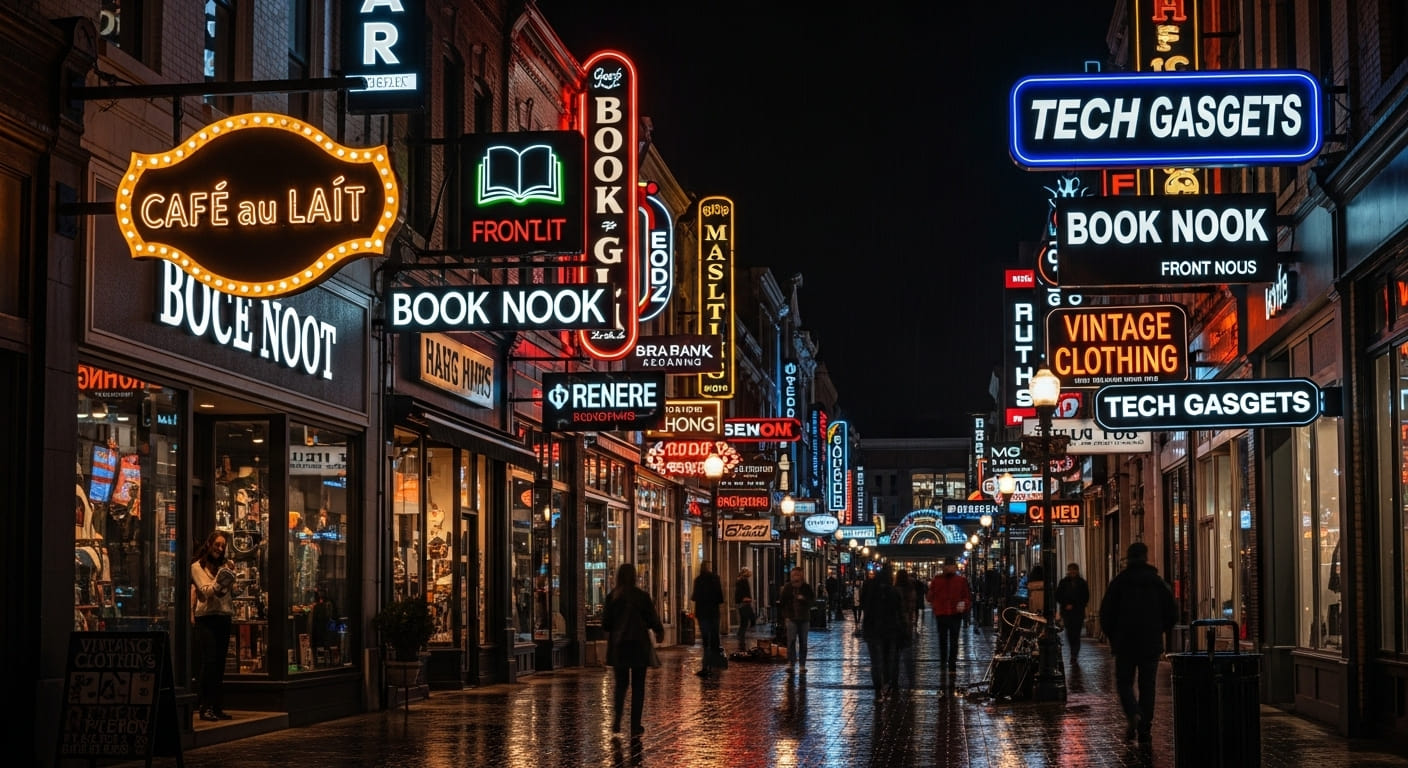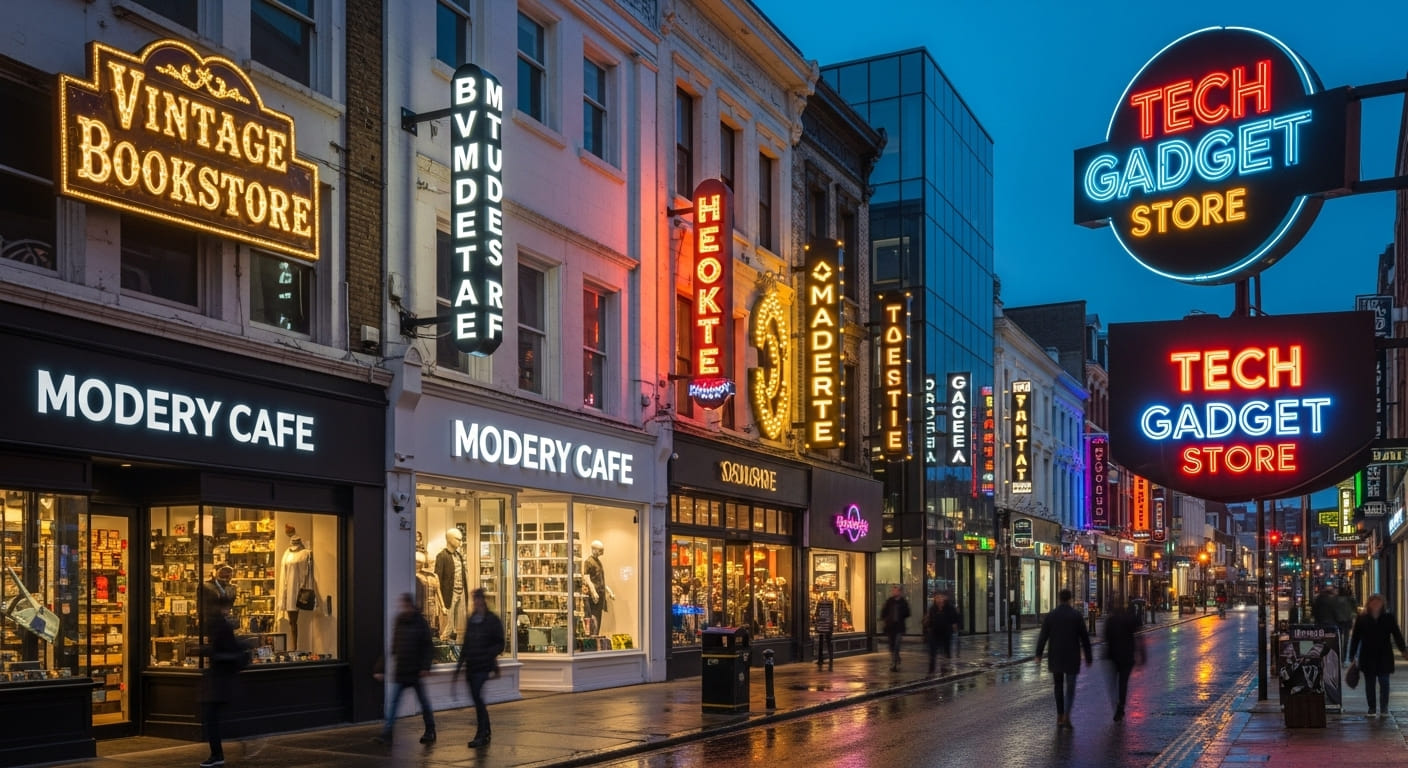If you’re running a business in Melbourne and looking to stand out after dark, 3D illuminated signs could be your best move. These eye-catching displays add depth and glow to your message, turning heads on busy streets like Collins or Swanston. In this guide, we’ll walk through everything from picking the perfect design to getting them up and running, all while keeping Melbourne’s local vibe in mind. Whether you’re a cafe owner in Fitzroy or a shopkeeper in the CBD, let’s dive in and see how 3D illuminated signs can light up your advertising.
Table of Contents
What Are 3D Illuminated Signs?
Picture this: bold letters or logos that pop out from the wall, lit up with a soft, inviting glow. That’s the magic of 3D illuminated signs. They use materials like acrylic or metal to create raised elements—think letters up to 30cm deep—that catch light in ways flat signs just can’t. The illumination comes from LEDs tucked inside or behind, making them shine bright without wasting energy.
In Melbourne’s mix of sunny days and chilly nights, these signs work year-round. They’re perfect for outdoor spots where foot traffic slows down as the sun sets. Related to broader signage trends, they tie into halo lighting for a modern edge or backlit panels for subtle drama. And with Australia’s push for eco-friendly options, most 3D illuminated signs now run on low-power LEDs, cutting down on your electricity bill while fitting the city’s green initiatives.
Benefits of Using 3D Illuminated Signs in Melbourne
Why bother with 3D illuminated signs when a simple sticker might do? Well, in a city as lively as Melbourne, visibility is key. These signs boost your brand’s presence by up to 40% at night, drawing in late-night walkers or drivers on the Monash Freeway. They’re durable against our unpredictable weather—rain, wind, even those rare hail storms—and last years with minimal upkeep.
Locally, they resonate with Melbourne’s creative spirit. Think of the neon buzz in laneways like Hosier, but elevated to 3D for a fresh twist. Businesses using them report more walk-ins, especially in multicultural areas where bold visuals cut through language barriers. Plus, with energy-efficient tech, they align with Victoria’s sustainability goals, like reducing light pollution in heritage zones. If you’re advertising events or sales, the dynamic glow of 3D illuminated signs makes your message memorable, encouraging shares on social media from passersby.
Choosing the Right Design for Your 3D Illuminated Signs
Getting the design right is where the fun starts. Start by matching your sign to your brand—curvy fonts for a trendy bar, blocky ones for a hardware store. In Melbourne, where street art influences everything, adding subtle colors like deep blues or vibrant greens can nod to the Yarra’s flow or local flora.
Materials and Lighting Options
Go for acrylic faces if you want crystal-clear light diffusion; it’s lightweight and weatherproof. Metal returns give that sturdy, industrial look popular in South Yarra warehouses. For lighting, front-lit edges create a sharp outline, while halo effects (light spilling behind) add mystery—great for evening crowds in the CBD.
LED strips are standard now, offering colors from cool white to warm amber. Dimmable options help comply with night-time rules, and smart controls let you sync with opening hours via an app.
Size and Placement Considerations
Scale matters: a 2m-wide sign suits a shopfront on Chapel Street, but scale down to 1m for tighter spots like arcade entrances. Placement? High enough to avoid vandalism but visible from trams. In heritage areas like Carlton, keep it flush to the wall to respect the old-world charm.
Consider cultural touches too—Melbourne’s diverse crowd appreciates inclusive designs, like bilingual text for Greek festivals in Lonsdale Street. Test mockups with local feedback to ensure your 3D illuminated signs feel welcoming.

Navigating Local Regulations for 3D Illuminated Signs in Melbourne
Jumping through hoops might sound dull, but Melbourne’s rules keep our skyline sharp and safe. Most 3D illuminated signs need a planning permit under Clause 52.05 of the Victoria Planning Provisions. If yours is under 10 square meters in commercial zones, you might qualify for a fast-track VicSmart permit—processed in weeks, not months.
Chat with your local council early; City of Melbourne has strict guidelines for the CBD, like no flashing lights near residential spots. Illuminated signs often go to Transport Victoria for review if near roads, ensuring they don’t dazzle drivers on St Kilda Road. And watch for light pollution curbs—a recent proposal aims to dim signs from midnight to sunrise on weekdays, so energy-efficient LEDs are a must.
Aerial approvals from CASA apply if you’re near airports like Tullamarine, limiting height and brightness. Fines for non-compliance? Up to $10,000, so budget for a consultant. On the plus side, compliant 3D illuminated signs can qualify for green rebates under Victoria’s sustainability programs.
Real-World Examples of 3D Illuminated Signs in Melbourne
Melbourne’s streets are a showcase for clever signage. Take a bustling car wash in Dandenong—its 3D letters in blue LED glow spell out the name, visible from the freeway and pulling in tired commuters. Or picture a Fitzroy coffee shop with halo-lit foam letters in earthy tones, blending with the area’s bohemian murals.
In the CBD, rooftop 3D illuminated signs on old warehouses nod to industrial history while lighting up night markets. Southbank eateries use backlit 3D logos to mirror the river’s sparkle, drawing tourists. Even pop-ups at festivals like White Night feature temporary 3D illuminated signs—quick-setup acrylic with battery LEDs—for that wow factor.
These examples show how 3D illuminated signs adapt to local scenes: bold in the suburbs, subtle in heritage lanes. Providers here craft them with Aussie resilience, using UV-resistant materials against our harsh sun.
Installation and Maintenance Tips
Once designed, installation is straightforward but needs pros. Secure mounts to brick or metal facades with anchors that handle 100km/h winds. Wiring? Concealed runs to avoid clutter, with IP65-rated seals for waterproofing.
Maintenance keeps them shining: clean faces quarterly with mild soap, check LEDs yearly for flickers. In Melbourne’s salty air near the bay, rinse off corrosion. Budget 5-10% of cost annually for tweaks. For longevity, opt for modular designs—swap a letter if needed without full replacement.
Questions and Answers: Common Questions About 3D Illuminated Signs in Melbourne
Q: What permits do I need to install 3D illuminated signs in Melbourne?
Ans: You’ll likely need a planning permit from your local council under Clause 52.05. Smaller signs under 10m² in commercial areas can use VicSmart for quicker approval. If near roads, get Transport Victoria’s nod too. Start by submitting sketches and specs—councils like Yarra or Port Phillip offer free advice sessions.
Q: How much do 3D illuminated signs cost in Melbourne?
Ans: Expect $2,000 to $10,000 depending on size and features. Basic 1m acrylic letters run $2,500 installed; larger LED halo setups hit $8,000. Factor in permits ($500+) and maintenance. Local makers often bundle design, so shop quotes from a few spots in Bayswater or Campbellfield.
Q: Where can I find reliable providers for 3D illuminated signs in Melbourne?
Ans: Head to industrial hubs like Campbellfield or Dandenong for workshops specializing in custom work. Many offer end-to-end service, from sketches to setup. Look for those with LED expertise and council compliance experience—reviews on local directories help spot the good ones.
Q: Are there restrictions on 3D illuminated signs in Melbourne’s CBD?
Ans: Yes, to fight light pollution, signs must dim after midnight on weekdays under new proposals. No flashing in heritage zones, and height limits near trams. Councils enforce brightness caps—aim for under 200 lux to stay safe. It’s all about balancing glow with neighborly peace.
Q: How long does it take to get 3D illuminated signs designed and installed in Melbourne?
Ans: From idea to glow, count 4-8 weeks. Design takes 1-2 weeks, permits 2-4, fabrication 1-2, and install a day. Rush jobs for events? Some spots deliver in 3 weeks, but book ahead for peak seasons like summer festivals.
Conclusion: Your Path to a Successful 3D Illuminated Signs in Australia
Wrapping it up, 3D illuminated signs offer a smart way to amp up your advertising in Melbourne’s dynamic scene. They’ve got the visibility to draw crowds, the durability for our weather, and the flexibility to fit local regs and cultures. From picking materials that shine just right to nailing those permits, you’ve got the tools here to make it happen.
Next steps? Sketch your vision, chat with a local expert for a quote, and apply for that permit today. Your glowing sign could be lighting up Bourke Street sooner than you think—turning browsers into buyers, one illuminated letter at a time. Ready to stand out Down Under? Let’s make it glow.

